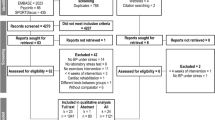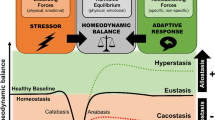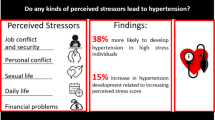Abstract
To identify unique cardiovascular responses to stressors in a population at genetic risk of hypertension, we studied haemodynamic responses in initial reactivity to, subsequent adaptation to, and final recovery from repeated active mental stress in young, normotensive individuals stratified by hypertension parental history (PH). Two groups (n=21/group) of normotensive white males underwent stress testing. One group (N+PH) had a hypertensive parent, while the other group (N-PH) did not. Cardiovascular response was measured before, during, and after repeated serial-subtraction math. Initial reactivity was measured as the difference between baseline and initial stress response, subsequent adaptation as the difference in response to repeated trials, and final recovery was assessed by the difference between baseline and postbaseline levels. The influence of PH on reactivity, adaptation, and recovery was assessed by repeated measures ANOVA for stroke volume, cardiac output, pre-ejection period, total peripheral resistance, mean successive heartbeat time difference, blood pressure, and heart rate. Multivariate analysis of variance (MANOVA) determined the effect of PH on overall reactivity, adaptation, and recovery. As compared to the N-PH group, initial reactivity was higher in the N+PH group for cardiac index (P<0.05) and pre-ejection period (P<0.05). Subsequent adaptation in the N+PH group was significantly slower for pre-ejection period (P=0.03). Finally, the N+PH group showed delayed recovery in heart rate (P=0.03), diastolic blood pressure (P<0.05), and pre-ejection period (P=0.007). In conclusion, the heightened reactivity, lack of adaptation, and delayed recovery occur in the sympathetic system of normotensive subjects at genetic risk of hypertension, specifically in beta-adrenergic responses (pre-ejection period). The parasympathetic response (mean successive heartbeat time difference) was not different. Increased cardiac output reactivity in the N+PH group (P<0.05) thus precedes any difference in blood pressure reactivity (P<0.99). Delayed recovery of diastolic blood pressure is also found in the N+PH group (P<0.05), which suggests lower baroreceptor sensitivity. Since delayed recovery in heart rate (P=0.03), and diastolic blood pressure (P<0.05) occur in N+PH subjects even before the corresponding changes in reactivity (P>0.10) or adaptation (P>0.07) are seen, these recovery impairments may be among the earliest precursors to the development of essential hypertension in this population. Finally, PH group haemodynamic differences suggest that these traits (reactivity, adaptation, and recovery) may constitute early ‘intermediate’ phenotypes in the pathogenesis of hypertension.
This is a preview of subscription content, access via your institution
Access options
Subscribe to this journal
Receive 12 digital issues and online access to articles
$119.00 per year
only $9.92 per issue
Buy this article
- Purchase on Springer Link
- Instant access to full article PDF
Prices may be subject to local taxes which are calculated during checkout

Similar content being viewed by others
References
Olson RP, Kroon JS . Biobehavioral treatment of essential hypertension. In: Schwartz MS (ed). Biofeedback: A Practitioner's Guide. The Guilford Press: New York, 1987, pp 316–339.
Julius S, Weder AB, Egan BM . Pathophysiology of early hypertension: implication for epidemiologic research. In: Gross F, Strasser T (eds). Mild Hypertension: Recent Advances. Raven Press: New York, 1983, pp 219–236.
Hallbach M, Folkow B . Physiopathology of spontaneous hypertension in rats. Cardiovascular responses to acute mental ‘stress’ in spontaneously hypertensive rats. Acta Physiol Scand 1974; 90: 684–698.
Jenkins CD et al. Biomedical and psychosocial predictors of hypertension in air traffic controllers. In: Spielberger CD, Sarason IG, Refars PB (eds). Stress and Anxiety, Vol. IX. McGraw-Hill Book Company: New York, 1984, pp 231–239.
Fredrikson M, Engel B . Cardiovascular and electrodermal adjustments during a vigilance task in patients with borderline and established hypertension. J Psychosom Res 1985; 29: 235–246.
Biagini M et al. Blood pressure response to exercise in young subjects with and without parental history of hypertension. J Hum Hypertens 1996; 10 (Suppl 3): 81–83.
Molineux D, Steptoe A . Exaggerated blood pressure response to submaximal exercise in normotensive adolescents with a family history of hypertension. J Hypertens 1988; 6: 361–365.
Anderson NB, Lane JD, Taguchi F, Williams Jr RB . Patterns of cardiovascular responses to stress as a function of race and parental hypertension in men. Health Psychol 1989; 8: 525–540.
de Visser DC et al. Cardiovascular response to mental stress in offspring of hypertensive parents: the Dutch Hypertension and Offspring Study. J Hypertens 1995; 13: 901–908.
Falkner B et al. Cardiovascular response to mental stress in normal adolescents with hypertensive parents. Hypertension 1979; 1: 23–30.
Gerin W, Pickering GT . Association between delayed recovery of blood pressure after acute mental stress and parental history of hypertension. J Hypertens 1995; 13: 603–610.
Glennon JM . Parental hypertension, negative affectivity, and cardiovascular recovery to cognitive challenge. Dissertation Abstr Int 1987; 47 (11-B): 4649.
O'Brien WH . Cardiovascular recovery from laboratory stressors as a function of a parental history of hypertension. Dissertation Abstr Int 1991; 51(10-B): 5037.
Schuler JL, O'Brien WH . Cardiovascular recovery from stress and hypertension risk factors: a meta-analytic review. Psychophysiology 1997; 34: 649–659.
Hastrup JL, Light KC, Obrist PA . Parental hypertension and cardiovascular response to stress in healthy young adults. Psychophysiology 1982; 19: 615–623.
Jorgenson RS, Houston BK . Family history of hypertension, personality patterns and cardiovascular reactivity to stress. Psychosom Med 1986; 48: 102–115.
Manuck SB, Proietti JM, Rader SJ, Polefrone JM . Parental hypertension, affect, and cardiovascular response to cognitive challenge. Psychosom Med 1985; 47: 189–200.
Obrist PA, Light KC, James SA, Strogatz DS . Cardiovascular responses to stress: 1. Measures of myocardial response and relationship to high resting systolic pressure and parental hypertension. Psychophysiology 1987; 24: 65–78.
Sausen KP, Lovallo WR, Wilson MF . Heart rate reactivity, behavior pattern, and parental hypertension as predictors of cardiovascular activity during cognitive challenge. Psychophysiology 1991; 28: 639–647.
Clayton RP et al. Aerobic power and cardiovascular response to stress. J Appl Physiol 1988; 65: 1416–1423.
Sinyor K et al. Aerobic fitness level and reactivity to psychosocial stress: physiological, biochemical and subjective measures. Psychosom Med 1983; 45: 205–217.
Cox RH . Developing strategies for stress management. In: Brown MR, Koob GF, Rivier J (eds). Stress Neurobiology and Neuroendocrinology. Marcel Dekker: New York, 1991, pp 615–640.
Borghi C et al. Predictors of stable hypertension in young borderline subjects: a five year follow-up study. J Cardiovasc Pharmacol 1986; 8 (Suppl 5): 138–141.
Ditto B . Parental history of essential hypertension, active coping and cardiovascular reactivity. Psychophysiology 1986; 23: 62–70.
Lyonfields JD, Borkovec TD, Thayer JF . Vagal tone in generalized anxiety disorder and the effects of aversive imagery and worrisome thinking. Behav Ther 1995; 26: 457–466.
Harris WS, Schoenfeld CD, Weissler AM . Effects of adrenergic receptor activation and blockade on the systolic pre-ejection period, heart rate and arterial pressure in man. J Clin Invest 1981; 46: 1704–1714.
ER Beaubien et al. Accuracy of the Dinamap 1846 XT automated blood pressure monitor. J Human Hypertens 2002; 16: 647–652.
Falkner B, Onesti G, Hamstra B . Stress response characteristics of adolescents with high genetic risk for essential hypertension: a five year follow-up. Clin Exp Hypertens 1981; 3: 583–591.
Carmelli D, Chesney MA, Ward MM, Rosenman RH . Twin similarity in cardiovascular stress response. Health Psychol 1985; 4: 413–423.
Allen MT, Obrist PA, Sherwood A, Crowell MD . Evaluation of myocardial and peripheral vascular responses during reaction time, mental arithmetic, and cold pressor tasks. Psychophysiology 1987; 24: 648–656.
Sloan RP, Korten JB, Myers MM . Components of heart rate reactivity, during mental arithmetic with and without speaking. Physiol Behav 1991; 50: 1039–1045.
Ditto B, France C, Miller S . Spouse and parent–offspring similarities in cardiovascular response to mental arithmetic and isometric hand-grip. Health Psychol 1989; 8: 159–173.
Stein PK, Boutcher SH . Heart rate and blood pressure responses to speech alone compared with cognitive challenges in the Stroop task. Percept Motor Skills 1993; 77: 555–563.
Tomaka J, Blascovich J, Swart L . Effects of vocalization on cardiovascular and electrodermal responses during mental arithmetic. Int J Psychophysiol 1994; 18: 23–33.
Julius S . Autonomic nervous dysfunction in essential hypertension. Diabetes Care 1991; 14: 249–259.
Folkow BS . Mental ‘stress’ and hypertension. Evidence from animal and experimental studies. Integr Physiol Behav Sci 1991; 26: 305–308.
Folkow BS . Early structural changes in hypertension: pathophysiology and clinical consequences. J Cardiovasc Pharmacol 1993; 22 (S-1): S1–S6.
Folkow BS . Kidneys and primary hypertension—initiators, stabilizers or/and victim-aggravators? Blood Pressure 1994; 3: 212–215.
Obrist PA . Cardiovascular Psychophysiology: A Perspective. Plenum Press: New York, 1981.
Sherwood A, Allen MT, Obrist PA, Langer AW . Evaluation of beta-adrenergic influences on cardiovascular and metabolic adjustments to physical and psychological stress. Psychophysiology 1986; 23: 89–104.
Julius S . Transition from high cardiac output to elevated vascular resistance in hypertension. Am Heart J 1988; 116(2 Part 2): 600–606.
Amarena J, Julius S . The role of the autonomic nervous system in hypertension. Hypertens Res 1995; 18: 99–110.
Julius S, Schork N, Schork A . Sympathetic hyperactivity in early stages of hypertension: the Ann Arbor data set. J Cardiovasc Pharmacol 1988; 12(Suppl 3): S121–S129.
Goldstein DS, Cannon RO, Zimlichman R, Keiser HR . Clinical evaluation of impedance cardiography. Clin Physiol 1986; 6: 235–251.
Dao TT et al. Expression of altered alpha-2-adrenergic phenotypic traits in normotensive humans at genetic risk of hereditary (essential) hypertension. J Hypertens 1998; 16: 779–792.
DiBona GF . Sympathetic nervous system and the kidney in hypertensions. Curr Opin Nephrol Hypertens 2002; 11: 197–200.
O'Connor DT et al. Early alteration in glomerular reserve in humans at genetic risk of essential hypertension: mechanisms and consequences. Hypertension 2001; 37: 898–906.
Song CK et al. Renal kallikrein excretion: role of ethnicity, gender, environment, and genetic risk of hypertension. J Hum Hypertens 2000; 14: 461–468.
Wong CM et al. Diminished renal kallikrein responses to mineralocorticoid stimulation in African-Americans: determinants of an intermediate phenotype for hypertension. Am J Hypertens 2003; 16: 281–289.
Obrist PA . Cardiac–behavioral interactions: a critical appraisal. In: Caccioppo JT, Petty RE (eds). Perspectives in Cardiovascular Psychophysiology. Guilford Press: New York, 1982, pp 265–296.
Manuck SB et al. Absence of enhanced sympathoadrenal activity and behaviorally evoked cardiovascular reactivity among offspring of hypertensives. Am J Hypertens 1996; 9: 249–255.
Eckoldt K et al. Sinus arrhythmia and heart rate in hypertonic disease. Adv Cardiol 1976; 16: 366–369.
Grossman P, Brinkman A, DeVries J . Cardiac autonomic mechanisms associated with borderline hypertension under varying behavioral demands: evidence for attenuated parasympathetic tone but not for enhanced beta-adrenergic activity. Psychophysiology 1992; 29: 698–711.
Miller SB . Parasympathetic nervous system control of heart rate responses to stress in offspring of hypertensives. Psychophysiology 1994; 31: 11–16.
Menkes MS et al. Cardiovascular reactivity to the cold pressor test as a predictor of hypertension. Hypertension 1989; 14: 524–530.
Ernest FA, Francis RA, Enwonwu CO . Manifest hostility may affect habituation of cardiovascular reactivity in blacks. Behav Med 1990; 16: 119–124.
Hummel TJ, Sligo J . Empirical comparison of univariate and multivariate analysis of variance procedures. Psychol Bull 1971; 76: 49–57.
Acknowledgements
We appreciate the assistance of Dr Mala Kailasam and Ms Justine Mount, as well as the advice of Dr Robert Parmer on operation of the BoMed and Finapres devices.
Author information
Authors and Affiliations
Corresponding author
Additional information
Support: Department of Veterans Affairs, National Institutes of Health.
Rights and permissions
About this article
Cite this article
Schneider, G., Jacobs, D., Gevirtz, R. et al. Cardiovascular haemodynamic response to repeated mental stress in normotensive subjects at genetic risk of hypertension: evidence of enhanced reactivity, blunted adaptation, and delayed recovery. J Hum Hypertens 17, 829–840 (2003). https://doi.org/10.1038/sj.jhh.1001624
Received:
Revised:
Accepted:
Published:
Issue Date:
DOI: https://doi.org/10.1038/sj.jhh.1001624
Keywords
This article is cited by
-
Body mass index in relation to cardiovascular recovery from psychological stress among trauma-exposed women
European Archives of Psychiatry and Clinical Neuroscience (2020)
-
Comparison of short-term heart rate variability indexes evaluated through electrocardiographic and continuous blood pressure monitoring
Medical & Biological Engineering & Computing (2019)
-
Forearm vasodilator responses to environmental stress and reactive hyperaemia are impaired in young South Asian men
European Journal of Applied Physiology (2018)
-
Analysis of beat-to-beat blood pressure variability response to the cold pressor test in the offspring of hypertensive and normotensive parents
Hypertension Research (2017)
-
Interactive Effects of Trait Self-Control and Stress Appraisals on Blood Pressure Responses to a Laboratory Stressor
International Journal of Behavioral Medicine (2017)



